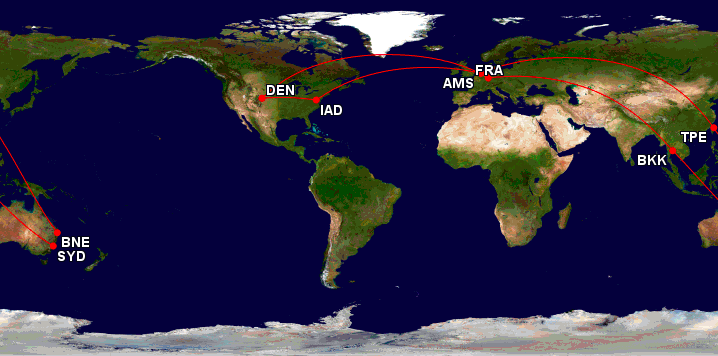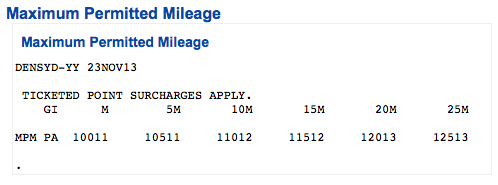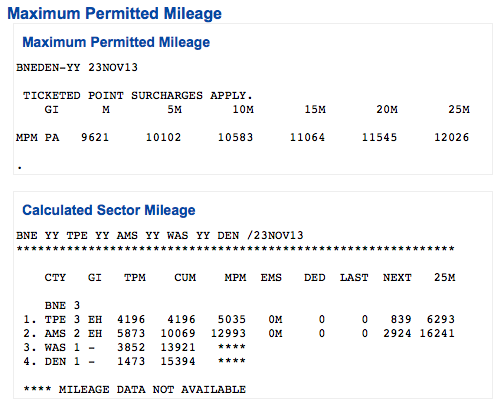US Airways mileage awards are perhaps the most enigmatic because there is seemingly no rhyme or reason to what is permitted and what is not. I laid out some general guidelines about booking US Airways awards, but six phone calls will result in six different interpretations of the rules. Still, I have found one method that generally results in a much smoother booking process–a simple routing.
That’s rather intuitive, I suppose, but not when you consider the routings you can book without hassle if you just keep the award to three segments in each direction. US Airways supposedly uses the maximum permitted mileage (MPM) guideline to determine if a routing is valid or not. Between two city pairs, an MPM is established that, put simply, defines the most miles it should take to get between two points. As a footnote, MPM can vary dramatically based on a routing over the Pacific or routing over the Atlantic and some US Airways agents will allow 25% over the published MPM.
But the point is that most US Airways agents will not check the MPM, particularly if the routing is simple. Let’s look at an example.
Australia has the most restrictive routing in the system–the MPM only allows for travel via the Pacific directly from North America or with a stop in Oceania. A stop in Asia, though a logical way to reach Australia, exceeds the MPM. A routing via the Atlantic, Europe, and Asia exceeds the MPM by more than 50%.
But I just booked the following routing all in business class for a Denver-based client:

- Denver to Frankfurt in Lufthansa Business Class
- Frankfurt to Bangkok in Thai Business Class
- Bangkok to Sydney in Thai Business Class
- Brisbane to Taipei in EVA Business Class
- Taipei to Amsterdam in EVA Business Class
- Amsterdam to Washington in United Business Class
- Washington to Denver in United Business Class
Why was I successful? The outbound had only two connections and the inbound three. It was simple and most agents will not question simple.
Here is the MPM for Australia from ExpertFlyer for the outbound from Denver to Sydney–

Note that the MPM is 10,011 miles, which requires a direct routing over the Pacific.
Take a look a the final outbound MPM–

Over 15,000 miles, a 50% overage!
The return offered an even greater disparity between the MPM and booked route–

MPM: 9621 miles. Actual: 15,394. It simply did not matter.
You will encounter agents who would not accept the routing above, but my own experience with US Airways suggests that agents appreciate being fed flights and as long as there are not too many stops, you can book any routing you desire.
That is something to remember if your goal is to get to Australia.
Keep in mind that the US Airways MasterCard is still offering a 30,000 mile-sign up bonus with 10,000 extra miles for balance transfers.
Most importantly, with the American Airlines merger approaching quickly, this card will not be avaiable much longer. US Airways is the best for using your miles to get to Australia.




Booked a 10-segment DM NAsia J award on AC/LX/OZ/TG/BR/SN/US before the plug is pulled. Had three itineraries on hold but let two expire. During the total of three calls I made the issue of too many miles, backtracking and two too many stops (the one being a matter of 15 minutes which they relented) although each itinerary was exactly the same – except the last one which routed YUL instead of FRA – save for dates! A real mixed reaction from agents. The first two itineries the agents put it to the rate desk, the third didn’t. The big reason why I let one itinerary expire was the high tax on one particular segment: USA-Switz via FRA vs. via YUL, or $367 vs. $179 for the 10 segment routing – FRA alone accounting for the $188 difference! So I went for YUL on AC instead of LH. At one time I tried to route USA-IST-MUC, then Asia. Said no, that’s backtracking although it was on UA’s award search. One agent said LHR-CDG-USA was backtracking, I said ‘not really’ and he let it through. All depends who’s on the phone.
What continent is Australia on? 😉